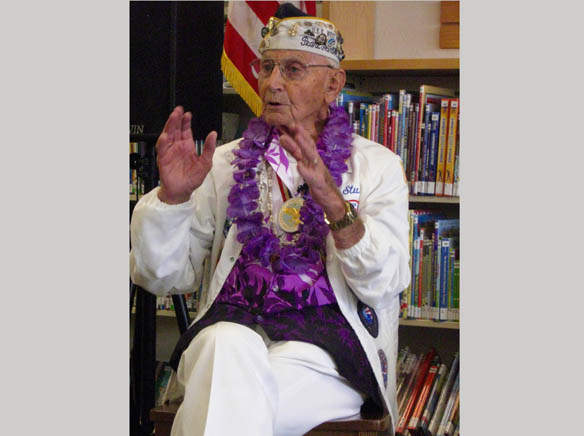“Do you remember where you were when you heard,” he asked the mature members of the audience? Retired U. S. Navy Chief Electrician’s Mate Stuart Hedley’s story centers on one specific date. One of three specific dates in American history for which people alive at the time recall exactly where they were and what they were doing when the news reached them. Two of the dates are Sept. 11, 2001 and Nov. 22, 1963, the terrorist attacks and the assassination of President Kennedy respectively.
“Do you remember where you were when you heard,” he asked the mature members of the audience? Retired U. S. Navy Chief Electrician’s Mate Stuart Hedley’s story centers on one specific date. One of three specific dates in American history for which people alive at the time recall exactly where they were and what they were doing when the news reached them. Two of the dates are Sept. 11, 2001 and Nov. 22, 1963, the terrorist attacks and the assassination of President Kennedy respectively. The third date is the surprise attack on Pearl Harbor by the Japanese on Dec. 7, 1941. It is of this date that Hedley was asking.
He was stationed aboard the battleship USS West Virginia (BB48) that morning. On this morning, nearly 75 years later, Hedley shared his story with those gathered at the Casa de Oro Library to remember Pearl Harbor veterans, an event co-sponsored by the Spring Valley Lions and Friends of Casa de Oro Library. The audience included veterans, students from Monte Vista and Steele Canyon High Schools, and a video crew from NHK, the Japan Broadcasting Corporation.
Setting out memorabilia on the provided table, Hedley was asked if he wanted to use the microphone and speaker system. He declined, with his strong, determined voice carrying easily to all. After the invocation, he stood tall and saluted while reciting the Pledge of Allegiance.
Looking around the room, his first spoke to the high school students, admonishing them to, “stay in school.” Using this as the starting point, he recounted how he came to be in the Navy and stationed aboard the USS West Virginia that fateful morning.
After some problems at home, his previously superb schoolwork went down hill and with it his plan to attend the U. S. Naval Academy. Determined to join the Navy, he travelled with his father to the Navy recruiter. After an academic test of sorts, he was told to come back after lunch for the physical. Measuring 4 feet 11 inches and 112 pounds, the doctor told him he was too small, because he did not meet the minimum requirements of 5 feet 2 inches and 122 pounds. Consequently, the Navy mentioned the Civilian Conservation Corps (CCC), which was helping prepare young men for the military.
With a letter from the Navy in hand, in the summer of 1939 Hedley went to the CCC to build himself up physically, mentally, and spiritually. He chopped down trees; trained to be a surveyor; and found his Christian faith. As he describes it, he had grown physically, mentally, and spiritually. Hedley, who measured himself on a regular basis, eventually grew to the required 5 feet 2 inches and added weight. So on August 20, 1940 he enlisted in the U. S. Navy.
After finishing basic training, he joined his first ship, the battleship USS West Virginia on Oct. 29 1940, and his 18th birthday. Sharing an anecdote from that first day aboard the West Virginia, he recounted somehow finding his way to the pilothouse, because he wanted to see the “steering wheel.” After asking an incredulous officer-in-charge about the steering wheel, Hedley was shown the helm, which is more like the control on a streetcar. With laughter ringing in the air, Hedley was assigned to his division and his battle station assignment as a gun pointer in the main battery of two 16-inch guns that fired shells weighing 2,700 pounds each.
For most of 1941, the West Virginia trained in the waters off Hawaii, the crew being told they were preparing to fight the Japanese navy at sea. The Admirals directed they were to spend more time at sea than in port and more than one battleship group would be in port at a time during this period. With a trace of bitterness, possibly anger, Hedley related that unbeknownst to the average sailor, some of the Admirals were “fired” and on November 26 1941 President Roosevelt ordered Admiral Kimmel and General Short to “prepare for sabotage,” which led to a total of 96 ships, including nine battleships, being collected together in Pearl Harbor and hundreds of aircraft parked side-by-side at five airfields in order to keep a close watch on everything. This was the situation just prior to the coming attack.
On the morning of Dec. 7, Hedley was getting ready for picnic with his girl friend, but could not find his best shoes and was told Pete Hartley had been wearing them the previous night. Using one of the ship’s models he had set up, Hedley described how he went down five deck levels to aft steering, where he found Hartley “sound asleep, drunk.” Collecting his shoes, he started back up topside, stopping for a cup of coffee in the quartermaster quarters. All of a sudden the command came over the 1MC speaker system, “away fire and rescue party.” The Officer of the Deck’s view was obscured because the USS Tennessee was alongside, but could see the fire on Ford Island, so called for the fire and rescue party.
Hedley said that when he got to his berthing area, he literally got a kick in the behind and was told to go to his battle station, because they were under attack and this was the “real thing.” Once getting on deck, he saw aircrew of a Japanese torpedo bomber flying down the port side of the ship. The Japanese attack had begun at 7:55 AM that Sunday morning.
At his battle station, he heard machine gun bullets hitting the turret and felt the ship lurch after being hit by a torpedo. The USS Arizona blew up and sank, taking with her 1,177 officers and crew, including the 89 members of the band, the same band that won the battle of the bands at the rec center the night before. Digressing a bit, he recalled how his father had taught him to sit with his feet under a chair, rather than leaning back on its rear legs. This, he offered, may have saved his life.
At battle stations, his normal position was sitting on a stool, with his feet stretched out on to the foot pedals in front of it. Subconsciously, he was sitting on the stool with his feet tucked underneath him when an armor-piercing round hit the turret. As a hatch blew across the space and sheared off the foot pedals where his feet normally would have been, he was spared serious injury or death by sitting with his feet under the stool. The armor piercing shell had not exploded, but gasoline from aircraft situated on catapults on the main deck caught fire, penetrating the space, landing on the recoil cylinder operated in part by glycerin. The glycerin exploded, killing 11 men instantly. Hedley said “only by the grace of God that I am alive.”
One of his shipmates said, “let’s get out of here,” so they climbed out of the turret on to the deck. Determined to get to the USS Tennessee that was alongside, the two of them ended up running down gun barrels, like running down railroad rails, leaping onto the adjacent ship. On the Tennessee, a Marine hollered at them to swim to the beach, so they jumped into the water, the surface of which was ablaze with burning oil. Hedley described swimming underwater, breaking the surface twice to the hottest air he ever breathed.
Once ashore, they were taken to the dispensary to help tend to the injured and dying with ointment for the burns, sulfur for the open wounds, and morphine for the dying and those in severe pain. Somberly he offered, “It was horrible to see the wounded.” He was there when the second wave of the Japanese attack came in at 8:55 AM. During this wave, a bomb hit the giant red cross in the center courtyard of the hospital, and the USS Oklahoma capsized, taking with her 429 men.
According to the Pearl Harbor Survivors Association, during the attack 18 American warships were sunk or damaged, 347 combat aircraft were destroyed or damaged, and 2,405 soldier, sailors, Marines, and civilians were killed, with another 1,178 wounded. 13 of the ships, including the USS West Virginia, were repaired and returned to service in the war.
Hedley returned to the West Virginia to fight fires aboard the ship, telling the audience that on checking his locker, his uniforms turned to dust when touched because of the intense heat from the fire. He recalled telling a close friend, “If I don’t get killed today, I’ll live through the war.” He went on to fight in several major battles of the war, not even receiving a scratch, even though a Kamikaze aircraft just missed the USS San Francisco on which he was serving. His friend was assigned to the USS Honolulu, where he was killed in action.
In a strange twist of fate, years later Hedley met Mitsuo Fuchida, the Japanese bomber pilot who led the first wave of the attack. Reportedly, Fuchida said, “I was trying to kill you,” to which Hedley replied, “You almost did.”
Throughout the presentation it is worth noting Hedley’s mention of specific individuals by name, telling of their actions at Pearl Harbor and later. Some were friends; others were remarkable for their bravery, and some for their leadership. At times, Hedley’s comments were blunt, even graphic such as how one sailor was decapitated. He clearly conveyed that war is gruesome.
Concluding his comments, Hedley exhorted those assembled to “Remember Pearl Harbor – Keep America Alert,” the motto of the Pearl Harbor Survivors Association.
Hedley remained in the Navy, serving a total of 20 years and 9 days before retiring. He then worked for the La Mesa Spring Valley School District for 20 years and a friend for another 20 years.















Does your website have a
Does your website have a contact page? I’m having problems locating
it but, I’d like to shoot you an e-mail. I’ve got some suggestions for your blog you might
be interested in hearing. Either way, great website
and I look forward to seeing it improve over time. https://www.meetme.com/apps/redirect/?url=http://arcticblastpainrelief.net/
Does your website have a
Does your website have a contact page? I’m having problems locating it but,
I’d like to shoot you an e-mail. I’ve got some suggestions for your blog you might be interested in hearing.
Either way, great website and I look forward to seeing it improve over time. https://www.meetme.com/apps/redirect/?url=http://arcticblastpainrelief.net/
Regards for helping out, good
Regards for helping out, good info. http://1522-5004.com/index.php?mid=board_zynH84&document_srl=206988
Regards for helping out, good
Regards for helping out, good info. http://1522-5004.com/index.php?mid=board_zynH84&document_srl=206988